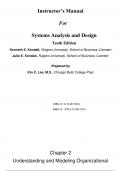Instructor’s Manual
For
Systems Analysis and Design
M
Tenth Edition
ED
Kenneth E. Kendall, Rutgers University, School of Business–Camden
Julie E. Kendall, Rutgers University, School of Business–Camden
C
Prepared by
O
Kin C. Lee, M.S., Chicago Bulls College Prep
N
N
O
IS
ISBN-10: 0-13-481730-3
ISBN-13: 978-0-13-481730-9
SE
U
R
Chapter 2
Understanding and Modeling Organizational
,Chapter 4 Systems Analysis and Design Instructor’s Manual 4-iv
Systems
Key Points and Objectives
1. Organizations are complex systems composed of interrelated and interdependent subsystems.
M
2. System and subsystem boundaries and environments have an impact on information system analysis and
ED
design.
3. Systems are described as either open, with free flowing information, or closed with restricted access to
information.
C
4. A virtual organization is one that has parts of the organization in different physical locations. They use
computer networks and communications technology to work on projects. Advantages of a virtual
O
organization are:
N
A. Reduced costs of physical facilities
B. More rapid response to customer needs
C. Flexibility for employees to care for children or aging parents
N
5. Enterprise systems or Enterprise Resource Planning (ERP) describes an integrated organizational
O
information system. The software helps the flow of information between the functional areas within the
organization.
IS
6. ERP can affect every aspect of the organization, such as:
A. Design of employees’ work
B. Skills required for job competency
C. Strategic positioning of the company
SE
7. Many issues must be overcome for the ERP installation is to be declared a success:
A. User acceptance
B. Integration with legacy systems and the supply chain
C. Upgrading functionality (and complexity) of ERP modules
U
D. Reorganizing work life of users and decision makers
E. Expanded reach across several organizations
F. Strategic repositioning of the company
R
8. A context-level data flow diagram is an important tool for showing data used and information produced by a
system. It provides an overview of the setting or environment the system exists within—which entities
supply and receive data/information.
9. The context-level data flow diagram is one way to show scope, or what is to be included in the system. The
project has a budget that helps to define scope.
Copyright © 2019 Pearson Education, Inc.
,Chapter 4 Systems Analysis and Design Instructor’s Manual 4-v
10. Entity-relationship diagrams help the analyst understand the organizational system and the data stored by the
organization.
11. There are three types of entities:
A. Fundamental entity, describing a person, place, or thing.
M
B. Associative entity (also called a gerund, junction, intersection, or concatenated entity), joining two
entities. It can only exist between two entities.
C. Attributive entity, to describe attributes and repeating groups.
ED
12. Relationships are shown with a zero or circle representing none, a vertical line representing one, or crow’s
foot representing many and can be:
C
A. One to one
B. One to many
C. Many to many
O
13. A use case diagram reflects the view of the system from the perspective of a user outside of the system.
N
14. A use case model partitions the way the system works into behaviors, services, and responses that are
significant to the users of the system.
N
15. A use case diagram has symbols for:
O
A. An actor, the role of a user of the system
B. The use case representing a sequence of transactions in a system
IS
16. There are two kinds of use cases:
SE
A. Primary, the standard flow of events within a system that describe a standard system behavior
B. Use case scenarios that describe variations of the primary use case
17. There are four active behavioral relationships:
U
A. Communicates—used to connect an actor to a use case.
R
B. Includes—describes the situation where a use case contains a behavior that is common to
more than one use case.
C. Extends—describes the situation where one use case possesses the behavior that allows
the new use case to handle a variation or exception.
D. Generalizes—implies that one thing is more typical than the other thing.
Copyright © 2019 Pearson Education, Inc.
, Chapter 4 Systems Analysis and Design Instructor’s Manual 4-vi
18. The steps required to create a use case model are:
A. Review the business specifications and identify the actors within the problem domain.
B. Identify the high-level events and develop the primary use cases that describe the events
and how actors initiate them.
C. Review each primary use case to determine possible variations of flow through the use
case.
M
D. Develop the use case documents for all primary use cases and all important use case
scenarios.
ED
19. Use case scenarios are text descriptions of the use case, and may contain the following:
A. The use case name and a unique ID
C
B. The area of the business
O
C. The actors
D. The stakeholders
N
E. The level
F. A brief description of the use case
N
G. The triggering event
O
H. The type of trigger, either external or temporal
I. The steps performed for the use case
IS
J. Preconditions, what must have occurred before the use case can start to execute
K. Postconditions, what has been accomplished by the use case
SE
L. Assumptions that have been made for the use case to execute
M. Requirements met by the use case
N. Minimum guarantee
U
O. Success guarantee
P. Any outstanding issues
R
Q. An optional priority
R. An optional risk
20. Use case levels describe how global or detailed the use case description is. Levels are:
A. White (like clouds): enterprise level
Copyright © 2019 Pearson Education, Inc.




